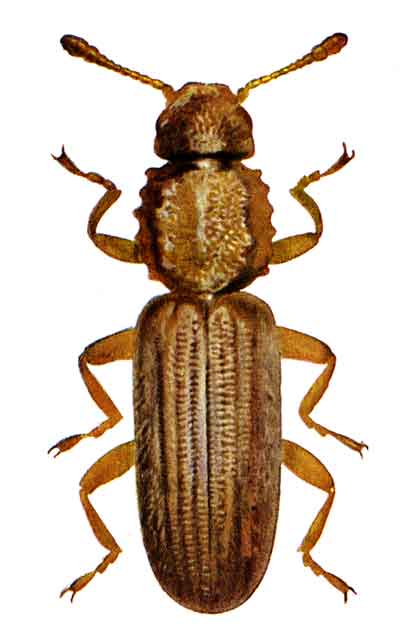|
 The Sawtoothed Grain Beetle is VERY flat, very narrow, and very small. It has been proposed that it is so small and flattened that it might even be able to work its way into a jar with a loose lid on it by following around the screw-cap ridges inside that lid. It is one beetle that service technicians run across most frequently and it usually is very difficult to trace to its source because of the wandering habit of the adult beetles. Imagine the top of a box of breakfast cereal. When you buy it at the store it is sealed shut. Or is it? The glue that is applied on the flaps to seal the box shut doesn't always provide a 100% seal. Even though the flaps look securely glued down if there is ANY crack that is not glued down, the very small, very flat Sawtoothed Grain Beetle adult can easily enter. It is difficult to design a practical package that will keep them out. The Sawtoothed Grain Beetle is VERY flat, very narrow, and very small. It has been proposed that it is so small and flattened that it might even be able to work its way into a jar with a loose lid on it by following around the screw-cap ridges inside that lid. It is one beetle that service technicians run across most frequently and it usually is very difficult to trace to its source because of the wandering habit of the adult beetles. Imagine the top of a box of breakfast cereal. When you buy it at the store it is sealed shut. Or is it? The glue that is applied on the flaps to seal the box shut doesn't always provide a 100% seal. Even though the flaps look securely glued down if there is ANY crack that is not glued down, the very small, very flat Sawtoothed Grain Beetle adult can easily enter. It is difficult to design a practical package that will keep them out.
It is easy to identify the Sawtoothed Grain Beetle because of the six "saw-like" projections on each side of the thorax that can be seen even without the use of a hand lens. This kind of a toothed edge is referred to as “serrated”. This beetle has well developed wings but it does not fly, but a very closely related species called the Merchant Grain Beetle CAN fly and may be the more common of the two species infesting our residential foods, given its stronger ability to move from place to place by flying. These two species and the differences between them are these:
- Sawtoothed Grain Beetle – Oryzaephilus surinamensis
- Unable to fly
- The space behind the compound eye to the back of the head is greater than half the width of that eye
- Merchant Grain Beetle – Oryzaephilus Mercator
- Well developed wings enable it to fly
- The space behind the compound eye to the back of the head is much less than half the width of the eye
This very slight but noticeable difference between these species is a great way to distinguish one from another, but in the real world it is not terribly important. Both kinds infest the same kinds of food products and are controlled in a similar manner. The Sawtoothed Grain Beetle occurs widely throughout North America and the world, and this is referred to as being “cosmopolitan”. They infest a great variety of foods and are very commonly found in home kitchens and pantries. This list includes nearly all stored grains and grain products, especially wheat, corn and barley. Other products that may be infested are flour, corn meal, corn starch, macaroni, breakfast cereals, wheat bran, oats, alfalfa seed, bird seed, dog food, graham crackers, herbs, spices, dried fruit, cocoa, nutmeats, dried figs, raisins, oil seeds, cookies, cake mixes, palm tree products and candy bars made with peanuts or puffed rice. They also infest cereal-based rodent baits.
Being so small, and thus having correspondingly small mandibles, these beetles are not well equipped to break into many whole grains, with their tough outer coat or shell. Instead, it is a scavenger that prefers to feed on the bits of dust or debris always found associated with stored foods. They are very active and will often be found wandering around in an infested account, helping to confuse the technician who is trying to locate the source.
The female Sawtoothed Grain Beetle lays her eggs singly or in small groups in the available food. Each female STGB lays an average of 375 eggs, deposited over a period of two to five days. In warm weather the eggs hatch in three to five days. At first the larvae are white in color and slow moving. As they mature they darken somewhat and become very active. Fully grown larvae are about 1/10" long, so you can see that a very careful inspection with a good flashlight and sharp eyes is needed to find them. The larval period lasts 12-15 days and then the larvae pupate in and on the materials upon which they have been feeding. The pupal period lasts about a week. An entire new generation of STGB can be produced about every 30 days, which allows populations to build up rapidly.
At Lady Bug we use a variety of environmentally responsible products to control pest activity. The ECO line of products we use are all EPA approved and are made from clove oil, guava fruit, rosemary and other organic products and naturally occurring materials. They are very effective against pests when injected into the cracks and crevices at the source of where pests live and breed, yet it is inaccessible to people and pets.
The Sawtoothed Grain Beetle Mesa, AZ
Contact Lady Bug Pest Control Specialists for a Free Home Inspection for Termites, Eco-Friendly Pest Control, Home Seal Service, Bed Bug Eco-Heat, and Rodent Control. We perform Complete Home Inspections at no charge. Please feel free to contact Lady Bug Pest Control Specialists to answer any questions or for a FREE Inspection. 480-833-1111.
|



 The
The 



